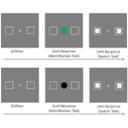Abstract
Internalizing regularities between motor responses and stimuli is crucial for adaptive functioning. However, the influence of these regularities on attentional selection remains poorly understood. This study explored whether responses, which predict the locations of search targets, direct attention toward these associated locations, a phenomenon termed response-induced attention. The experiments consist of acquisition and test phases. In the acquisition phase, participants performed a dual task involving an identification task followed by a search task. In the identification task, participants responded to the color of an object presented at the center. Immediately after this response, a search target appeared on either the left or right side. Critically, the response for the identification target predicted a more probable location of the search target. Faster responses for search targets were observed at the response-cued location than the other location, suggesting an attentional bias toward the response-cued location. In the test phase, the colors of identification targets were changed, and the responses for the identification targets were no longer informative about the search target locations. Nevertheless, search remained faster when targets appeared at the response-cued location, suggesting that responses, not colors, guided attention. This response-induced attention effect was observed in Experiment 1, where responses predicted spatially compatible target locations, as well as in Experiments 2 and 3, where they predicted incompatible locations. Experiment 4 confirmed that the observed effects resulted from the spatial distribution of attention. These findings provide new insights into the ability to learn response-stimulus regularities for the intelligent allocation of attention, demonstrating the significant role of the motor dimension in attentional selection.
